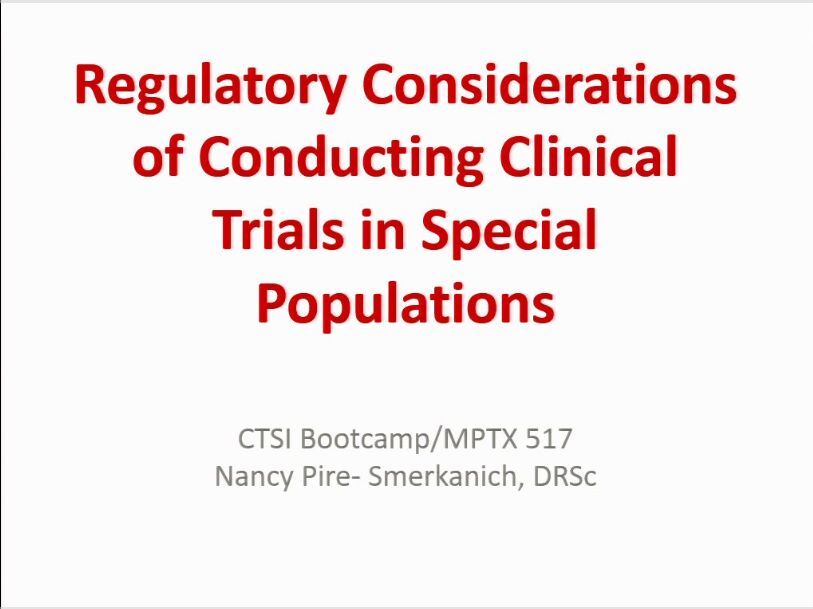- Disclaimer
- Not all regulatory considerations are ethical considerations.
- US centric
- Never ignore the ethics of the regulatory science
- Why conduct clinical trials in special populations?
- Important Questions that must be answered such effective interventions, is there an impact, cons vs. pros
- Why companies may not want to?
- Liability
- Profit margin is small
- Special Populations
- Regulations call for additional safeguards for populations for whom the standard requirements may not offer sufficient protection
- Examples: neonates, pregnant women
- 1966: The Beecher report (Henry Beecher)
- Highlights gross deviations in clinical trials methods
- No control groups, failure to inform of gross risk, use of vulnerable populations, no oversight from a neutral informed party ie. IRB
- Led to the development of the Belmont Report
- Highlights gross deviations in clinical trials methods
- Vulnerable Populations
- Increased scrutiny for vulnerable individuals is based on the basic premises of the Belmont Report
- Respect for the person---autonomy/info
- Beneficence---medical benefit
- Justice---fairness in choice of pop.
- Can not make fully informed decisions
- Circumstances are not always permanent ex. Neonate
- Ability to give consent
- Access to quality healthcare ex. Affordable Care Act
- Question: Less access to health care can cause individuals to more likely participate in clinical trials?
- Increased scrutiny for vulnerable individuals is based on the basic premises of the Belmont Report
- Who are vulnerable populations?
- Children
- Prisoners
- Pregnant women and their unborn child
- For three above groups, federal regulations specific to those corresponding groups exist
- Mentally ill/challenged
- Military
- Other Populations:
- Vulnerability can come from …
- Not limited to one specific/entire pop.
- Not limited to chronic situation
- Unequal perception of power ie. student vs. professor
- Created by need of services, assistance, or protection
- Cultural, ethnic, or religious beliefs
- Vulnerability can come from …
- Regulations
- US Code of Federal Regulations requires IRBs approve research involving vulnerable participants only when “additional safeguards” are included
- 45 CFR 46- Protection of Human Subjects
- National Bioethics Advisory Committee Categories
- Types of Vulnerability:
- Cognitive/Communicative ex. Stressful pregnancy & language barrier
- Institutional
- Deferential
- Medical
- Economic
- Social
- Types of Vulnerability:
- Questions of Vulnerability:
- Are you vulnerable forever?
- When is a child not a child?
- Start and end of vulnerability?
- Are emotionally disabled persons always vulnerable?
- Do justice, beneficence, and respect for persons ever conflict?
- Determining Vulnerability
- Individualized vulnerability also exists
- Group Identification
- Pros: Easier to identify, easier to mandate special protections, and production of appropriate culturally and linguistic forms
- Cons: Overlooks individual variations, being part of multiple groups, status of group may change, periodic vulnerability, stigma
- IRB Responsibility
- Regularly reviewing research involving these categories
- Risk Categories (Ref: 45 CFR 46 D: Children)
- Case Study - Children (40% of the world’s population) but only 10% of drugs are approved for pediatric uses
- Lack of specifics labels pertaining to this demographic
- History of Pediatrics Drug development
- No children in drug develop before BPCA and PREA
- Best Pharmaceuticals for Children Act (BPCA)
- Law in 2002
- To encourage pharm. industry to perform pediatric studies to improve labeling and for the NIH to prioritize therapeutic areas and sponsor clinical trials for further research in children
- Pediatric research Equity Act of 2003 (PREA)
- Gave FDA more authority to require pediatric studies of drugs
- Gave specific areas for waivers
- Now in the US, Pediatric Study Plans are now required as New Drug Applications
- Must be actively thought during product development
- Lessons Learned for Pediatric Populations
- Variable pharmacokinetics
- Adverse reactions to pediatric medication will need to be defined
- Consider ethical issues and trial designs
- Why have sponsors been reluctant to test drugs in pediatrics?
- Economics: high cost and small market
- Difficult recruitment and non-compliance
- Failure of trials due to poor dosing
- Ethnics: Children bear “minimal risk”
- Liability: Legal problems
Regulatory Science Symposium: Special Populations Session 8: Regulatory Considerations of Conducting Clinical Trials in Special Populations (2017)
In this session, we will discuss the extrinsic considerations for special populations.
Regulatory Science
Research Ethics
Responsible Conduct of Research
Special Populations
Nancy Pire-Smerkanich, DRSc, MS
Assistant Professor, USC Mann Dept. of Regulatory and Quality Sciences; Associate Director, Regulatory Knowledge and Support
Course Syllabus/Topics
Acknowledgement
Accompanying text created by Annie Ly | Undergraduate Research Associate and Provost's First Generation Research Fellow | lyannie@usc.edu

